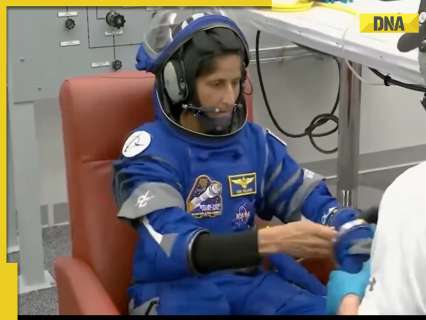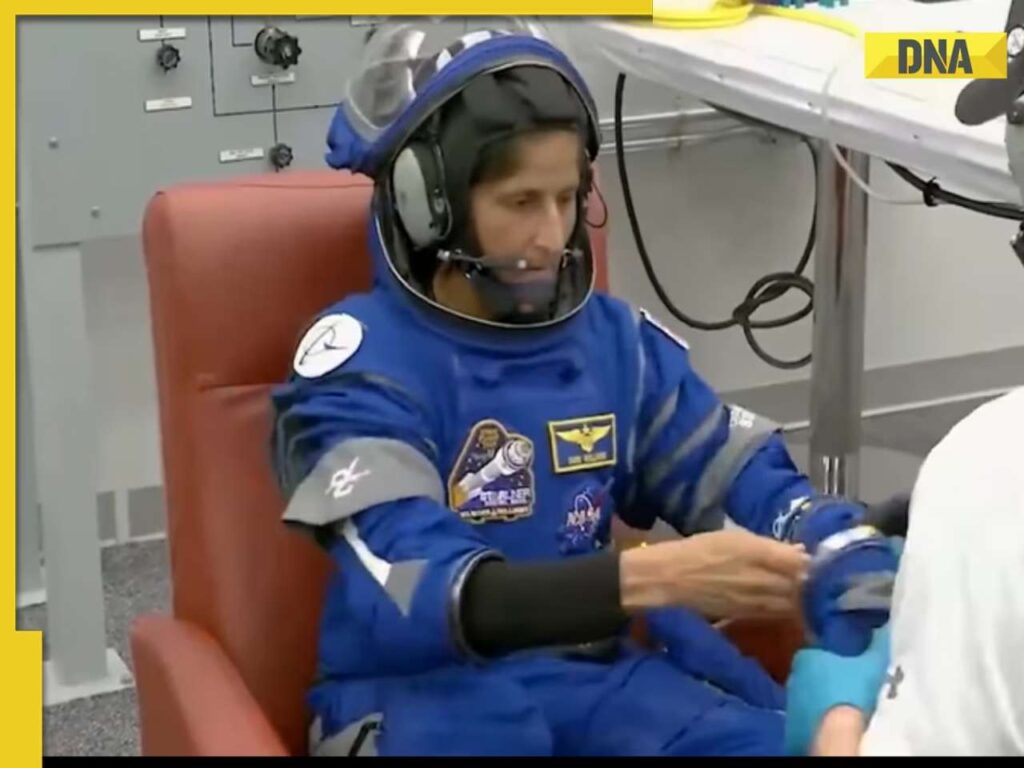
The Crew-9 team (comprised of 4 members) is expected to leave the International Space Station about a week after NASA’s SpaceX Crew-10 mission arrives.
NASA is set to launch the Crew-10 mission on March 12 using an older SpaceX Dragon capsule. This mission will also bring astronauts Butch Wilmore and Sunita Williams back home to Earth.
NASA astronauts Butch Wilmore and Sunita Williams, who have been stuck on the International Space Station since last June, might come back to Earth sooner than planned using the SpaceX Dragon crew spacecraft.
The Crew-9 team (comprises of 4 members) is expected to leave the International Space Station about a week after NASA’s SpaceX Crew-10 mission arrives.
NASA’s SpaceX Crew-9 team, which includes NASA astronauts Nick Hague, Sunita Williams, and Butch Wilmore, along with Roscosmos cosmonaut Aleksandr Gorbunov, recently had a refresher training to get ready for their return to Earth.
The crew used a computer to practice reentry steps, making sure they are ready for a safe return to Earth aboard the SpaceX Dragon spacecraft.
The Crew-9 team will leave the International Space Station about a week after NASA’s SpaceX Crew-10 mission arrives.
NASA’s SpaceX Crew-10 mission is set to launch on March 12 from the Kennedy Space Center in Florida. The team includes NASA astronauts Anne McClain and Nichole Ayers, Roscosmos cosmonaut Kirill Peskov, and JAXA astronaut Takuya Onishi. They will travel to the International Space Station (ISS).
This crew swap is part of NASA’s plan to keep astronauts on the ISS at all times, allowing them to continue important research and daily operations.
With the Crew-10 mission coming up, NASA and SpaceX are teaming up to make sure everything goes smoothly and the Commercial Crew Program stays on track.
Crew-10 will use a Dragon spacecraft that has flown before, helping speed up the launch and showing how reusable space technology is both useful and efficient.
The Fiery Descent: Basics of Re-entry and SpaceX Crew Dragon’s Return
When objects from space re-enter Earth’s atmosphere, they face intense challenges. High-speed collisions with air molecules create immense heat, requiring careful engineering to ensure safety.
Basics of Re-entry:
As an object enters, it encounters gas molecules, initially traveling at 7-8.5 km/s (25,200-30,600 km/h). Slowing down, it passes Mach 1 (0.34 km/s or 1,235 km/h), generating a sonic boom as it breaks the sound barrier. Spacecraft returning from low Earth orbit, moving at approximately Mach 25 (8.5 km/s or 30,600 km/h), break apart air molecules, forming a superheated plasma. This plasma necessitates robust heat shields.
Launch and re-entry demands are opposite: launch minimizes drag with sleek and pointed shapes, while re-entry maximizes drag with rounded shapes for deceleration. The Space Shuttle’s thermal protection, using silicone tiles and reinforced carbon-carbon (RCC), highlights the importance of heat shielding. The tragic loss of Space Shuttle Columbia, due to RCC damage during launch, underscores the critical nature of these systems. Re-entry durations range from 6 to 30 hours.
SpaceX Crew Dragon Re-entry: A Detailed Breakdown with Speed Management
The return of a SpaceX Crew Dragon from the International Space Station (ISS) is a precisely orchestrated event, marked by careful speed management.
1. Undocking and Initial Departure:
- The Crew Dragon detaches from the ISS, initiating a “soft undock.”
- Small thruster firings create a safe separation distance. Speed is minimal, allowing for drift away from the ISS.
2. Preparations for Re-entry:
- Crew dons SpaceX spacesuits, performing leak checks.
- The Dragon spacecraft gets ready for its de-orbit burn by turning itself so that its heat shield faces the right direction. This helps protect it as it re-enters Earth’s atmosphere.
- The “trunk” (a section of the spacecraft that carries cargo and houses the solar panels) is detached and released. This reduces the spacecraft’s weight, helping it prepare for a smooth re-entry into Earth’s atmosphere.
3. De-orbit Burn:
- The Draco thrusters (small engines that help control the spacecraft’s movement) fire up to perform a de-orbit burn. This maneuver slows down the spacecraft, allowing it to leave orbit and begin its journey back to Earth.
- The Dragon spacecraft needs to travel at a speed of about 17,500 miles per hour (28,000 kilometers per hour) to stay in orbit around Earth. This high speed creates a balance between the spacecraft’s forward motion and Earth’s gravitational pull. If it moves too slowly, gravity will pull it down, causing it to fall back to Earth. The de-orbit burn (a controlled engine firing) slightly slows the spacecraft, making its lowest point in orbit (perigee) drop. This helps it leave orbit and begin re-entry into Earth’s atmosphere.
- This targets the splashdown location.
4. Atmospheric Re-entry:
- The Dragon encounters the atmosphere at 17,500 miles per hour (28,000 kilometers per hour).
- Atmospheric friction decelerates the spacecraft.
- The PICA-X heat shield absorbs heat, reaching 1,600 degrees Celsius.
- The spacecraft slows down rapidly, experiencing strong forces that push against it.
- Plasma formation causes a communications blackout.
5. Parachute Deployment:
- When the spacecraft slows down to subsonic speed (which means it is traveling slower than the speed of sound, or less than 1,235 km/h), small parachutes called drogue parachutes open up. These parachutes help steady the capsule and prepare it for the main parachutes to deploy.
- Main parachutes reduce speed to 15-17 miles per hour (24-27 kilometers per hour).
6. Splashdown:
- The Dragon splashes down in the ocean at 15-17 miles per hour (24-27 kilometers per hour).
- Recovery teams approach.
7. Crew Recovery:
- Recovery personnel secure the capsule.
- The crew exits, and medical checks are performed.
- The crew is transported to land.
Key Speed Reduction Factors:
- De-orbit Burn: Initiates orbital velocity reduction.
- Atmospheric Friction: High-speed deceleration.
- Parachutes: Final speed reduction.
SpaceX’s re-entry process showcases precision and engineering for safe astronaut returns.
(The author of this article is an award-winning Science Writer and a Defence, Aerospace & Political Analyst based in Bengaluru. He is also Director of ADD Engineering Components, India, Pvt. Ltd, a subsidiary of ADD Engineering GmbH, Germany. You can reach him at: [email protected])

